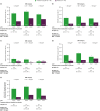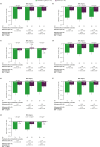Tofacitinib Efficacy/Safety in Patients with Ankylosing Spondylitis by Baseline Body Mass Index: A Post Hoc Analysis of Phase 2/3 Trials
- PMID: 39636343
- PMCID: PMC11751278
- DOI: 10.1007/s40744-024-00726-6
Tofacitinib Efficacy/Safety in Patients with Ankylosing Spondylitis by Baseline Body Mass Index: A Post Hoc Analysis of Phase 2/3 Trials
Abstract
Introduction: We assessed tofacitinib efficacy and safety in ankylosing spondylitis (AS) by body mass index (BMI) category.
Methods: Data were pooled from phase 2/3 trials; analyses included patients with active AS randomized (1:1) to tofacitinib 5 mg twice daily or placebo, who were stratified by baseline BMI into < 25, ≥ 25 to < 30, and ≥ 30 kg/m2 categories. Efficacy was assessed at week 12 and safety to week 16.
Results: Of 370 patients, 153, 131, and 86 had a baseline BMI of < 25, ≥ 25 to < 30, and ≥ 30 kg/m2, respectively. At baseline, patients with BMI < 25 kg/m2 were younger and more likely to be current smokers/Asian, and patients with BMI ≥ 30 kg/m2 had higher mean waist circumference/swollen joint count (SJC) and were more likely to have enthesitis, high-sensitivity C-reactive protein (hsCRP) > 5 mg/L, an inadequate response to tumor necrosis factor inhibitors (TNFi), and prior biologic disease-modifying anti-rheumatic drug (bDMARD) use versus other categories. Across categories, tofacitinib responses/improvements were greater than with placebo, except for ≥ 40% Assessment of SpondyloArthritis international Society improvement (ASAS40), ASAS partial remission, 50% improvement from baseline in the Bath Ankylosing Spondylitis Disease Activity Index score (BASDAI50), and Ankylosing Spondylitis Disease Activity Score using C-reactive protein (ASDAS-CRP) inactive disease rates, which were similar for tofacitinib and placebo in the BMI ≥ 30 kg/m2 category. Treatment effects were similar across categories, except for BASDAI50, which was smaller in the BMI ≥ 30 category versus the < 25 kg/m2 category. More adverse events (AEs) and serious adverse events (SAEs) with tofacitinib were reported in the BMI < 25 kg/m2 category, which had a higher proportion of current smokers versus other categories.
Conclusions: Regardless of baseline BMI category, efficacy was greater with tofacitinib versus placebo in patients with AS, and no treatment effect differences between categories were observed, with exceptions for BMI ≥ 30 kg/m2 (more active/treatment-refractory disease and a smaller sample size). Overall, tofacitinib safety was generally comparable across categories; however, AE/SAE rates with tofacitinib were higher in the BMI < 25 kg/m2 category (which had more current smokers). This post hoc analysis demonstrates that tofacitinib can be considered as a treatment option for AS, regardless of baseline BMI category; however, interpretation was limited by small sample sizes and differences in sample sizes and baseline characteristics across categories.
Trial registration: ClinicalTrials.gov identifiers, NCT01786668 and NCT03502616.
Keywords: Body mass index; Randomized controlled trial; Rheumatology; Therapeutics.
© 2024. The Author(s).
Conflict of interest statement
Declarations. Conflict of Interest: Hillary Norton has received grants and/or research support from AbbVie, Eli Lilly, Horizon, Novartis, and Scipher; has been an advisor for AbbVie, Amgen, AstraZeneca, Eli Lilly, Horizon, Janssen, Novartis, Pfizer Inc., Scipher, and UCB; and has been a member of the speakers’ bureau for AbbVie, Amgen, Eli Lilly, Janssen, Horizon, Novartis, Sanofi-Aventis, and UCB. Paula Sliwinska-Stanczyk and Tomas Hala have no disclosures. Bassel El-Zorkany has received grants and/or research support from Pfizer Inc. and Roche and has acted as a consultant for AbbVie, Amgen, Bristol Myers Squibb, Eli Lilly, Eva, Hekma, Inspire, Janssen, MSD, New Bridge, Novartis, Pfizer Inc., Roche, Sanofi-Aventis, and Servier. Lori Stockert, Rajiv Mundayat, and Lisy Wang are employees and stockholders of Pfizer Inc. Christopher T. Ritchlin has acted as a consultant for AbbVie, Bristol Myers Squibb, Eli Lilly, Janssen, Novartis, Pfizer Inc., and UCB and has received grants and/or research support from AbbVie, Janssen, Pfizer Inc., and UCB. Ethical Approval: Both trials were conducted in accordance with the Declaration of Helsinki and Good Clinical Practice Guidelines of the International Council for Harmonisation and were approved by the relevant Institutional Review Board and/or Independent Ethics Committee of the investigational centers. All patients provided written, informed consent, which is applicable to all medical research conducted using data from these studies, including this post hoc analysis. As all patients provided informed consent, all of the data included in this analysis were covered by the original ethical review/approval process. Consequently, no additional ethical review/approval was required for this post hoc analysis.
Figures


References
-
- Taurog JD, Chhabra A, Colbert RA. Ankylosing spondylitis and axial spondyloarthritis. N Engl J Med. 2016;374:2563–74. - PubMed
-
- Durcan L, Wilson F, Conway R, Cunnane G, O’Shea FD. Increased body mass index in ankylosing spondylitis is associated with greater burden of symptoms and poor perceptions of the benefits of exercise. J Rheumatol. 2012;39:2310–4. - PubMed
Associated data
LinkOut - more resources
Full Text Sources
Medical
Research Materials
Miscellaneous

